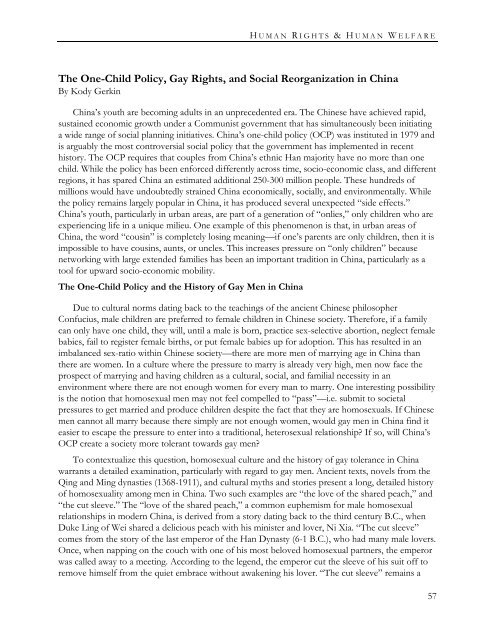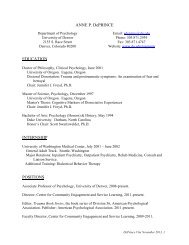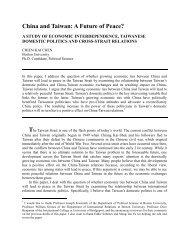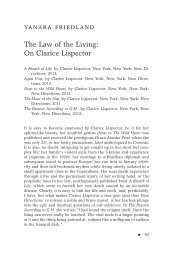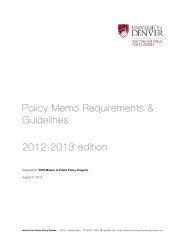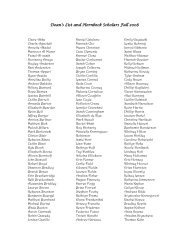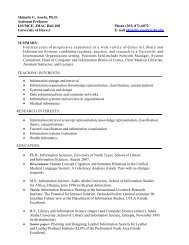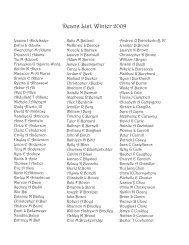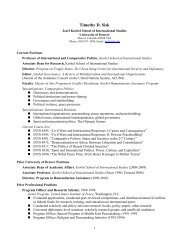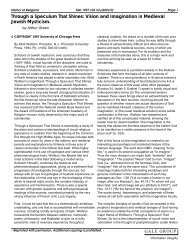The One-Child Policy, Gay Rights, and Social
The One-Child Policy, Gay Rights, and Social
The One-Child Policy, Gay Rights, and Social
You also want an ePaper? Increase the reach of your titles
YUMPU automatically turns print PDFs into web optimized ePapers that Google loves.
H UMAN R IGHTS & H UMAN W ELFARE<br />
<strong>The</strong> <strong>One</strong>-<strong>Child</strong> <strong>Policy</strong>, <strong>Gay</strong> <strong>Rights</strong>, <strong>and</strong> <strong>Social</strong> Reorganization in China<br />
By Kody Gerkin<br />
China’s youth are becoming adults in an unprecedented era. <strong>The</strong> Chinese have achieved rapid,<br />
sustained economic growth under a Communist government that has simultaneously been initiating<br />
a wide range of social planning initiatives. China’s one-child policy (OCP) was instituted in 1979 <strong>and</strong><br />
is arguably the most controversial social policy that the government has implemented in recent<br />
history. <strong>The</strong> OCP requires that couples from China’s ethnic Han majority have no more than one<br />
child. While the policy has been enforced differently across time, socio-economic class, <strong>and</strong> different<br />
regions, it has spared China an estimated additional 250-300 million people. <strong>The</strong>se hundreds of<br />
millions would have undoubtedly strained China economically, socially, <strong>and</strong> environmentally. While<br />
the policy remains largely popular in China, it has produced several unexpected “side effects.”<br />
China’s youth, particularly in urban areas, are part of a generation of “onlies,” only children who are<br />
experiencing life in a unique milieu. <strong>One</strong> example of this phenomenon is that, in urban areas of<br />
China, the word “cousin” is completely losing meaning—if one’s parents are only children, then it is<br />
impossible to have cousins, aunts, or uncles. This increases pressure on “only children” because<br />
networking with large extended families has been an important tradition in China, particularly as a<br />
tool for upward socio-economic mobility.<br />
<strong>The</strong> <strong>One</strong>-<strong>Child</strong> <strong>Policy</strong> <strong>and</strong> the History of <strong>Gay</strong> Men in China<br />
Due to cultural norms dating back to the teachings of the ancient Chinese philosopher<br />
Confucius, male children are preferred to female children in Chinese society. <strong>The</strong>refore, if a family<br />
can only have one child, they will, until a male is born, practice sex-selective abortion, neglect female<br />
babies, fail to register female births, or put female babies up for adoption. This has resulted in an<br />
imbalanced sex-ratio within Chinese society—there are more men of marrying age in China than<br />
there are women. In a culture where the pressure to marry is already very high, men now face the<br />
prospect of marrying <strong>and</strong> having children as a cultural, social, <strong>and</strong> familial necessity in an<br />
environment where there are not enough women for every man to marry. <strong>One</strong> interesting possibility<br />
is the notion that homosexual men may not feel compelled to “pass”—i.e. submit to societal<br />
pressures to get married <strong>and</strong> produce children despite the fact that they are homosexuals. If Chinese<br />
men cannot all marry because there simply are not enough women, would gay men in China find it<br />
easier to escape the pressure to enter into a traditional, heterosexual relationship? If so, will China’s<br />
OCP create a society more tolerant towards gay men?<br />
To contextualize this question, homosexual culture <strong>and</strong> the history of gay tolerance in China<br />
warrants a detailed examination, particularly with regard to gay men. Ancient texts, novels from the<br />
Qing <strong>and</strong> Ming dynasties (1368-1911), <strong>and</strong> cultural myths <strong>and</strong> stories present a long, detailed history<br />
of homosexuality among men in China. Two such examples are “the love of the shared peach,” <strong>and</strong><br />
“the cut sleeve.” <strong>The</strong> “love of the shared peach,” a common euphemism for male homosexual<br />
relationships in modern China, is derived from a story dating back to the third century B.C., when<br />
Duke Ling of Wei shared a delicious peach with his minister <strong>and</strong> lover, Ni Xia. “<strong>The</strong> cut sleeve”<br />
comes from the story of the last emperor of the Han Dynasty (6-1 B.C.), who had many male lovers.<br />
Once, when napping on the couch with one of his most beloved homosexual partners, the emperor<br />
was called away to a meeting. According to the legend, the emperor cut the sleeve of his suit off to<br />
remove himself from the quiet embrace without awakening his lover. “<strong>The</strong> cut sleeve” remains a<br />
57
T OPICAL R ESEARCH D IGEST: H UMAN R IGHTS IN C HINA<br />
popular literary term for male homosexuality. During the seventeenth century, references to<br />
homosexual acts among men within popular Chinese literature rose to previously unseen levels. In<br />
1740, homosexuality figured so prominently in the public consciousness that the newly empowered<br />
Qing dynasty drafted a law that prohibited consensual sodomy. This law, as recorded in court<br />
records from the era, targeted acts of sodomy between men. <strong>The</strong> drafting <strong>and</strong> application of the<br />
sodomy law implied that female homosexuality or sodomy between men <strong>and</strong> women were perceived<br />
as less dangerous to the maintenance of society than coital expressions of male homosexuality.<br />
<strong>The</strong> omnipotence of Confucian thought in the history of Chinese culture is worth noting.<br />
Confucius was a Chinese philosopher who wrote <strong>and</strong> lectured during the fourth <strong>and</strong> fifth century<br />
B.C. Undoubtedly, Confucianism has fundamentally shaped <strong>and</strong> colored Chinese culture. <strong>The</strong> clarity<br />
with which Confucian thought defines the roles of men, women, <strong>and</strong> children—if society is to<br />
function properly—leaves no space for expressions of homosexuality among men. Filial piety is a<br />
strict code of conduct described by Confucius with regard to the role of men, women, children, <strong>and</strong><br />
elders within the familial structure. Confucian thought, specifically the notion of filial piety,<br />
inherently favors the birth of male children, who are seen as more capable than women of carrying<br />
on the family name. While homosexuality is never mentioned by Confucius, he does make clear the<br />
role of man, first as an obedient son, <strong>and</strong> later as a faithful husb<strong>and</strong> <strong>and</strong> father. Chinese culture,<br />
influenced profoundly by Confucianism, allows men in modern China the option of entering into<br />
private homosexual relationships, as long as they publicly enter into heterosexual relationships,<br />
marry, <strong>and</strong> bear at least one child. This creates unsatisfying social arrangements for gay men, the<br />
women who gay men marry, <strong>and</strong> the children these couples bear.<br />
Chinese Tolerance toward <strong>Gay</strong> Men: Is This a Human <strong>Rights</strong> Issue?<br />
In 1995, the first official pamphlet to acknowledge homosexuality in China was released in<br />
response to growing incidences of HIV/AIDS in mainl<strong>and</strong> China. <strong>The</strong> Chinese government’s<br />
longst<strong>and</strong>ing inability to admit that homosexuality exists in China complicates their approach to<br />
reducing HIV/AIDS transmissions among gay men. <strong>The</strong> denial surrounding Chinese homosexuality<br />
affects the nature of both the government’s approach to promoting the rights of gay men <strong>and</strong> their<br />
efforts to fight the spread of HIV/AIDS. It cannot be assumed that, in publishing this pamphlet<br />
<strong>and</strong> other similar literature, the government’s official recognition of homosexuality translates to<br />
healthier sexual, cultural, <strong>and</strong> social interactions among gay men. In fact, the opposite may be true.<br />
When the government releases pamphlets <strong>and</strong> information that allude to homosexual practices, the<br />
literature reflects the government’s naïve presuppositions regarding homosexuality among men in<br />
modern China: namely, that homosexuality is immoral, anti-Chinese, <strong>and</strong> a medical condition or,<br />
worse yet, a disease. <strong>The</strong> government cannot be a trusted expert on homosexuality when, by <strong>and</strong><br />
large, it pretends that homosexuality is not a natural tendency among human beings. <strong>The</strong> implicit<br />
ideology of the 1995 pamphlet, for example, implies that if gay men are armed with knowledge<br />
about HIV/AIDS—specifically the increased prevalence of the disease among homosexuals <strong>and</strong> the<br />
increased likelihood of transmitting the disease during anal sex—they will stop being gay.<br />
Chinese policy’s focus on homosexuality as a disease is an ineffective <strong>and</strong> dangerous approach to<br />
reducing the transmission rates of HIV/AIDS. Furthermore, it places a storied subset of the<br />
Chinese population in a state of chronic isolation. <strong>The</strong> Chinese government sponsors HIV/AIDS<br />
testing in China, not to identify the ill for medical treatment, but to expose dangerous carriers who<br />
pose a serious threat to public health. This provides little to no motivation for those who fear they<br />
may be infected to seek testing. If the Chinese government is not willing to accept the notion that<br />
58
H UMAN R IGHTS & H UMAN W ELFARE<br />
homosexuality, with its long history in Chinese culture, remains a practice among men in modern<br />
China, then society as a whole is being denied the fundamental human right of having access to the<br />
information <strong>and</strong> tools necessary to combat the spread of lethal diseases such as HIV/AIDS.<br />
Furthermore, as long as homosexuality is seen as an anti-Chinese disease, gay men <strong>and</strong> women will<br />
not have the personal freedom to express love, lust, <strong>and</strong> companionship in a safe environment that<br />
is free from government oppression.<br />
Hope for the Future<br />
<strong>The</strong> government has largely succeeded in convincing the Chinese population that homosexuality<br />
in China is not a condition that exists naturally among humans. This helps the government frame<br />
homosexuality as a disease. Given the rich history of the practice of homosexuality among men in<br />
China, this approach must change. Government policy impacts both sexes—if the government<br />
refuses to recognize homosexuality as a natural component of the human capacity to love, then gay<br />
men will continue to marry women. <strong>The</strong>se men, bowing to social pressures, will have the allotted<br />
one child, <strong>and</strong> likely will continue to practice homosexuality in private places. This leaves the women<br />
<strong>and</strong> children to lives of sorrow <strong>and</strong> grief, trapped in hollow, unsatisfying familial arrangements.<br />
Guided research on the OCP’s potential impact on the gay community would create the possibility<br />
for promoting safer cultural <strong>and</strong> social spaces for homosexuality among men. With increased<br />
tolerance towards homosexuality, Chinese men <strong>and</strong> women would not suffer due to needless stigma,<br />
discrimination, <strong>and</strong> oppression.<br />
Annotations<br />
Arnold, Fred, <strong>and</strong> Liu Zhaoxiang. 1986. “Sex Preference, Fertility, <strong>and</strong> Family Planning in China.”<br />
Population <strong>and</strong> Development Review 12 (2): 221-246.<br />
Annotation: Arnold <strong>and</strong> Zhaoxiang used extensive field research <strong>and</strong> compiled data from<br />
more than one million interviews while researching for this article. <strong>The</strong>y examine the effects<br />
of China’s one-child policy on the rising gender imbalance among the Chinese population.<br />
<strong>The</strong> authors examine practical aspects of the phenomena, such as the use of contraceptives<br />
<strong>and</strong> gender selective abortion in modern China. <strong>The</strong>y also take into account long-st<strong>and</strong>ing<br />
cultural traditions, particularly the widespread practice of Confucian customs in rural areas,<br />
which tend to motivate families to have male children. Arnold <strong>and</strong> Zhaoxiang examine the<br />
extent to which any of these factors have a real or perceived effect on the gender imbalance<br />
in China. Far-reaching <strong>and</strong> data heavy, the article makes a clear case for altering Chinese<br />
family planning strategies to favor gender equity among birth rates, particularly in rural<br />
China.<br />
Aird, John S. 1990. Slaughter of the Innocents: Coercive Birth Control in China.<br />
Washington, DC:<br />
American Enterprise Institute (AEI) Press.<br />
Annotation: Aird makes a compelling case that population control policies in China started<br />
long before the adoption of the one-child policy. Drawing from primary resources, mainly<br />
59
T OPICAL R ESEARCH D IGEST: H UMAN R IGHTS IN C HINA<br />
60<br />
official government documents <strong>and</strong> directives, Aird divides the book into three major<br />
sections: the use of coercion <strong>and</strong> human rights concerns with regard to China’s one-child<br />
policy; birth control policies from 1949-1983; <strong>and</strong> finally, the contradictions <strong>and</strong> different<br />
interpretations of Party Document Numbers seven <strong>and</strong> thirteen. Aird contends that the<br />
Chinese government has shielded both the domestic population <strong>and</strong> the international<br />
community from the more brutal aspects of Chinese population control measures. <strong>The</strong> book<br />
is informative <strong>and</strong> includes extensive bibliographic information; it is fitting for anyone<br />
interested in exploring the harsh reality of China’s one-child policy.<br />
Blum, Susan Debra, <strong>and</strong> Lionel M. Jensen. 2002. China Off Center: Mapping the Margins of the<br />
Middle Kingdom. Honolulu: University of Hawai’i Press.<br />
Annotation: <strong>The</strong> goal of this extensive volume is to illustrate that China is more diverse in<br />
ideology, language, ethnicity, region, <strong>and</strong> religion than Western scholars typically assume.<br />
<strong>The</strong> authors of the various essays highlight China’s ability to manufacture a homogenous<br />
image to foreigners while simultaneously recognizing the Western tendency to view China as<br />
a “centered” empire. However, the authors hope that, through a focus on the “particular, the<br />
local <strong>and</strong> the puzzling,” a picture may emerge of many Chinas, wherein “flux is the only<br />
constant.” Readers with an interest in Chinese-specific ideologies concerning sexual behavior<br />
will find Liu, Ng, Zhou, <strong>and</strong> Haebele’s essay, “Sexual Behavior in Modern China”<br />
particularly fascinating. <strong>The</strong> authors’ extensive research on sexual norms <strong>and</strong> “premarital <strong>and</strong><br />
extramarital relations, homosexual relations…satisfaction with sexual practices <strong>and</strong> so<br />
forth,” is of interest to anyone looking to deepen their underst<strong>and</strong>ing of China’s diverse<br />
opinions on human sexuality.<br />
Dalsimer, M. <strong>and</strong> L. Nisonoff. 1987. “<strong>The</strong> Implications of the New Agricultural <strong>and</strong> <strong>One</strong>-<strong>Child</strong><br />
Family Policies for Rural Chinese Women.” Feminist Studies 13 (3): 583-607.<br />
Annotation: Laurie Nisonoff, a professor of economics at Hampshire College in Amherst,<br />
<strong>and</strong> Marlyn Dalsimer, a professor at Dartmouth, have collaborated extensively on works<br />
relating to women’s issues in rural China. In this piece, they argue that the lack of<br />
effectiveness of China’s one-child policy becomes clear when one examines the impact the<br />
policy has had on rural Chinese women in terms of their “work, family life, <strong>and</strong> fertility.”<br />
<strong>The</strong> authors’ succinct review of the policy’s history <strong>and</strong> presentation of possible alternative<br />
strategies for population control are accessible <strong>and</strong> should be of interest to anyone<br />
concerned with issues affecting rural Chinese women.<br />
Duberman, Martin B., Martha Vicinus, <strong>and</strong> George Chauncey (eds.). 1989. Hidden from History:<br />
Reclaiming the <strong>Gay</strong> <strong>and</strong> Lesbian Past.<br />
New York: New American Library.<br />
Annotation: Editors Duberman, Vicinus, <strong>and</strong> Chauncey spent four years collecting various<br />
essays in an attempt to fill the void of comprehensive analysis on the development of gay<br />
culture around the world. <strong>The</strong> editors insist that, “for a century, the history of homosexuality
H UMAN R IGHTS & H UMAN W ELFARE<br />
has been constrained by the intolerance of governments <strong>and</strong> academics alike.” In the essay<br />
“Homosexuality <strong>and</strong> the State in Late Imperial China,” Vivien W. Ng uses political writings,<br />
novels, <strong>and</strong> scholarly journal entries to explain the rising interest in male homosexuality that<br />
China experienced in the fifteenth <strong>and</strong> sixteenth centuries. Ng concludes by examining the<br />
legislative backlash that the implicit acceptance of homosexuality inspired in the Chinese<br />
political bureaucracy. Both the essay <strong>and</strong> the book provide valuable insights for anyone<br />
interested in deepening their grasp of homosexuality as expressed in national <strong>and</strong> cultural<br />
contexts around the globe<br />
Falbo, Toni, <strong>and</strong> Dudley L. Poston, Jr. 1993. “<strong>The</strong> Academic, Personality, <strong>and</strong> Physical Outcomes of<br />
Only <strong>Child</strong>ren in China.” <strong>Child</strong> Development 64 (1): 18-35.<br />
Annotation: Falbo <strong>and</strong> Poston examine representative samples of four thous<strong>and</strong> children<br />
from four different Chinese provinces with the aim of revealing differences between<br />
children in single versus multiple child families. Through their extensive analysis of the data<br />
collected, the authors ultimately establish that China is not creating a generation of only<br />
children who are fundamentally different from their peers who have siblings. <strong>The</strong>y note that<br />
Western scholarship may have created the myth of “little emperors,” a phrase used<br />
domestically <strong>and</strong> internationally to connote children born into single child Chinese families.<br />
To explain the rise of this notion, which their research refutes, the authors discuss cultural<br />
differences between the West <strong>and</strong> China. For example, Chinese youth introduce themselves<br />
to strangers not by name, but by their rank within the familial structure, i.e. “I am my<br />
father’s second daughter.” <strong>Social</strong> scientists will find the detailed explanations of the pair’s<br />
research methodologies insightful <strong>and</strong> informative.<br />
Fong, V. L. 2007. “Parent-<strong>Child</strong> Communication Problems <strong>and</strong> the Perceived Inadequacies of<br />
Chinese Only <strong>Child</strong>ren.” Ethos 35 (1): 85-127.<br />
Annotation: Harvard Professor Vanessa Fong is well-known for her extensive research on<br />
what will undoubtedly be the lasting effects of China’s one-child policy. In this article, she<br />
asserts that China’s youth, particularly those born into one child families, have chronic<br />
behavioral problems <strong>and</strong> “unsatisfactory personalities.” She supports these claims through<br />
the presentation of five longitudinal case studies of Chinese families. <strong>The</strong>se children’s<br />
behavioral problems, she contends, result from mixed messages <strong>and</strong> unclear guidance that<br />
Chinese parents give their children. Of particular consequence is the dissonance that<br />
develops between only children <strong>and</strong> their parents, who were brought up in a different<br />
familial structure. This is relevant in terms of the only child’s perceived ability to achieve<br />
upward mobility within modern Chinese society, a society of only children. Scholars,<br />
students, <strong>and</strong> all parties interested in the one-child policy’s effect on youth will find this<br />
study useful.<br />
61
T OPICAL R ESEARCH D IGEST: H UMAN R IGHTS IN C HINA<br />
Gil, Vincent E. 1992. “<strong>The</strong> Cut Sleeve Revisited: A Brief Ethnographic Interview with a Male<br />
Homosexual in Mainl<strong>and</strong> China.” <strong>The</strong> Journal of Sex Research 29 (4): 569-577.<br />
62<br />
Annotation: Vincent Gil uses one interview with an openly homosexual singer in a major,<br />
mainl<strong>and</strong> Chinese city to open theoretical space on the subject of homosexuality in China.<br />
<strong>The</strong> transcribed <strong>and</strong> translated interview accounts for about half of the article. Gil maintains<br />
that homosexuality is frowned upon, stating that this is a result of cultural remnants left over<br />
from Confucian notions of the roles of men in families. He states that, “even now in the<br />
post-Maoist period, it is argued that no ‘homosexual tradition’ as such exists today or is<br />
known, even among the educated. In mainl<strong>and</strong> China there is an adherence to seeing the<br />
sexual world according to moral ideals rather than empirical realities.” <strong>The</strong> interview is useful<br />
insofar as it illustrates the connections between the male homosexual experience in mainl<strong>and</strong><br />
China versus other cultural <strong>and</strong> national settings around the world, particularly the United<br />
States. <strong>The</strong> interviewee’s story would suggest that men in mainl<strong>and</strong> China adapt their<br />
homosexual behavior to the cultural, legal, <strong>and</strong> social norms of their environment.<br />
Greenhalgh, S., <strong>and</strong> J. Bongaarts. 1987. “Fertility <strong>Policy</strong> in China: Future Options.” Science 235<br />
(4793): 1167-1172.<br />
Annotation: <strong>The</strong> authors, an associate <strong>and</strong> senior associate, respectively, of the Center for<br />
<strong>Policy</strong> Studies in New York, employ a broad range of demographic, social, <strong>and</strong> economic<br />
measures to present alternatives to China’s one-child policy. Relying on mathematical<br />
projections, Greenhalgh <strong>and</strong> Bongaarts explore outcomes of one <strong>and</strong> two-child models in<br />
addition to models such as “stop at two <strong>and</strong> delay <strong>and</strong> space.” <strong>The</strong> authors explore both the<br />
macro <strong>and</strong> micro-deficiencies of the current policy <strong>and</strong> demonstrate how alternative models<br />
would better suit the Chinese economy, the rights of women, <strong>and</strong> the ability of families to<br />
support the elderly. Scholars <strong>and</strong> social scientists would find the article’s in-depth analysis<br />
useful as a tool for underst<strong>and</strong>ing population projections <strong>and</strong> the history of alternative<br />
strategies to the one-child policy.<br />
Hesketh, <strong>The</strong>rese, Lu Li, <strong>and</strong> Wei Xing Zhu. 2005. “<strong>The</strong> Effect of China’s <strong>One</strong>-<strong>Child</strong> Family <strong>Policy</strong><br />
after 25 Years.” New Engl<strong>and</strong> Journal of Medicine 353 (11): 1171-1176.<br />
Annotation: Hesketh, Li, <strong>and</strong> Zhu present a succinct account of the history of China’s onechild<br />
policy <strong>and</strong> the myriad ways it has affected China in the twenty-five years since its<br />
inception. <strong>The</strong> authors draw primarily on statistics gathered from census data <strong>and</strong> other<br />
scholarly articles written on the topic. Specific impacts that are covered in the article include<br />
the policy’s effect on population growth, the use of contraceptives, the sex-ratio, <strong>and</strong> old-age<br />
dependency in China. <strong>The</strong> authors conclude with a brief section on the future of the onechild<br />
policy. <strong>The</strong> format is such that graphs <strong>and</strong> easily-accessible charts are presented <strong>and</strong><br />
followed by broad, clear analysis. Readers of any kind will find the article a useful, concise<br />
introduction to the policy’s varied effects on Chinese society.
H UMAN R IGHTS & H UMAN W ELFARE<br />
Hinsch, B. 1990. Passions of the Cut Sleeve: <strong>The</strong> Male Homosexual Tradition in China. Berkeley,<br />
University of California Press.<br />
Annotation: Bret Hinsch has published extensively on the history of sexual <strong>and</strong> other<br />
traditions in Chinese culture. Hinsch’s approach to the study of male homosexuality in China<br />
is refreshing, <strong>and</strong> any interested scholar will find it a well-researched introduction to the<br />
topic. What is unique about Hinsch’s approach is that he refuses an imposition of Western<br />
values in his study, seeking an underst<strong>and</strong>ing of male homosexuality that is Chinese-specific.<br />
Hinsch relies primarily on available Chinese texts, from ancient to modern times, <strong>and</strong> he<br />
weaves aspects of Chinese culture from “romance <strong>and</strong> lewdness, tolerance <strong>and</strong> violence,<br />
power <strong>and</strong> poverty,” into a narrative of homosexual identity. He explores the meaning <strong>and</strong><br />
implication of homosexuality in society from political dynasty to political dynasty. By<br />
framing his account within cultural myths <strong>and</strong> romanticized stories of homosexual love,<br />
Hinsch succeeds in revealing the import <strong>and</strong> relevance of the male homosexual tradition in<br />
Chinese society.<br />
Hull, Terence H. 1990. “Recent Trends in Sex Ratios at Birth in China.” Population <strong>and</strong> Development<br />
Review 16 (1): 63-83.<br />
Annotation: Terence Hull presents three plausible theories as to why the sex ratio in China<br />
has been rising, “reaching 111 males per 100 females in 1986-87.” According to the author,<br />
infanticide, abortion, “faulty statistical reporting,” or, more likely, a combination of all three<br />
practices accounts for the sex ratio disparity. Either way, Hull argues, women are suffering as<br />
a result. Hull reasons that, if women have been left out of census data <strong>and</strong> are hidden away<br />
from the government’s sight, then they are likely not enrolled in school or involved in formal<br />
healthcare. Hull utilizes scant data but presents it in concise, readable graphs. His analysis<br />
consists mostly of hypotheses <strong>and</strong> conjecture, but his logical explanations <strong>and</strong> commonsense<br />
analysis make his article an appealing read for anyone interested in a historical<br />
overview of the growing sex ratio disparity in modern China.<br />
Jones, Rodney H. 1999. “Mediated Action <strong>and</strong> Sexual Risk: Searching for ‘Culture’ in Discourses of<br />
Homosexuality <strong>and</strong> AIDS Prevention in China.” Culture, Health & Sexuality 1 (2): 161-180.<br />
Annotation: Jones examines homosexual culture in China within the view of the Chinese<br />
government, specifically in the context of the ways in which HIV/AIDS education <strong>and</strong><br />
prevention campaigns are coordinated <strong>and</strong> implemented. In terms of how to combat the<br />
HIV/AIDS epidemic in China, Jones hopes that, by avoiding Western <strong>and</strong> Chinese cultural<br />
<strong>and</strong> social definitions of homosexuality, one could “reframe the question from one which<br />
sees individuals as parts of culture to one which sees cultures as parts of individuals.”<br />
Through analysis of government documents regarding HIV/AIDS education <strong>and</strong><br />
prevention, Jones reveals the multi-layered nature of China’s official view of homosexuality.<br />
For example, when discussing the condom, he notes how it is often mentioned that<br />
condoms are not one hundred percent effective. Whereas abortion is an option to avoid<br />
63
T OPICAL R ESEARCH D IGEST: H UMAN R IGHTS IN C HINA<br />
64<br />
unwanted pregnancy within heterosexual relations, there is “no turning back,” with respect<br />
to AIDS, if a condom fails. <strong>The</strong>refore, “preserving moral integrity” is the only way that<br />
avoiding AIDS is assured. This article is useful for anyone who seeks to explore HIV/AIDS<br />
prevention <strong>and</strong> education in cross-cultural contexts.<br />
Kane, P., E. J. Croll, et al. 1985. China’s <strong>One</strong>-<strong>Child</strong> Family <strong>Policy</strong>.<br />
Basingstoke, Hampshire:<br />
Macmillan.<br />
Annotation: Written by a group of experts in topics ranging from feminism in China to<br />
Chinese elderly persons <strong>and</strong> population control, this book explores several phenomena<br />
already observable in the early 1980s as a result of China’s one-child policy. <strong>The</strong> book<br />
resulted from a meeting of experts in 1983, when the policy was only four years old.<br />
Suggesting that the findings may be tentative, the editors note that the work gives an<br />
extensive overview of the history of the policy <strong>and</strong> the government’s justification for it.<br />
<strong>The</strong>se features make the collection of essays an excellent introduction to the topic, which<br />
most readers will find useful.<br />
Louie, Kam, <strong>and</strong> Morris Low. 2003. Asian Masculinities: <strong>The</strong> Meaning <strong>and</strong> Practice of Manhood in<br />
China <strong>and</strong> Japan. London; New York: Routledge.<br />
Annotation: Louie <strong>and</strong> Low’s work makes a significant contribution to the exploration of<br />
masculinity in a specifically Asian context. <strong>The</strong> authors deliberately disconnect their own<br />
analysis from traditional discussions on masculinity, claiming that the majority of Western<br />
literature is of little value when searching for meanings of masculinity in China or Japan.<br />
Through an examination of ancient texts <strong>and</strong> more recent studies on patterns among varied<br />
social groups, including male soldiers, athletes, artists, <strong>and</strong> businessmen in both China <strong>and</strong><br />
Japan, the authors explore how masculinity has evolved over time <strong>and</strong> in different ways<br />
between the two nations. <strong>The</strong>ir findings would be useful for academics interested in the<br />
construction of masculinity within cross-cultural contexts.<br />
McBeath, Jerry, <strong>and</strong> Jenifer McBeath. 2009. “Environmental Stressors <strong>and</strong> Food Security in China.”<br />
Journal of Chinese Political Science 14 (1): 49-80.<br />
Annotation: In this article, the McBeaths present a succinct overview of some of China’s<br />
most pressing environmental stress factors. More specifically, they focus on the Chinese<br />
government’s attempts to address these problems in order to ensure sufficient grain<br />
production <strong>and</strong> food security. Extensive citation of China’s state-controlled, daily English<br />
language newspaper may draw criticism from some readers; the paper is censored heavily<br />
<strong>and</strong> known for its favorable portrayal of the Chinese government. <strong>The</strong> McBeaths contend<br />
that China’s one-child policy is the “single most important reduction of environmental stress<br />
to have occurred globally in the past generation.” <strong>The</strong>ir analysis of the government’s efforts<br />
to mollify environmental stressors from the 1970s through 2008 offers a well-rounded<br />
introduction to the proposed efficiency of the Chinese government’s initiatives.
H UMAN R IGHTS & H UMAN W ELFARE<br />
Mosher, S. W. 1993. A Mother’s Ordeal: <strong>One</strong> Woman’s Fight against China’s <strong>One</strong>-<strong>Child</strong> <strong>Policy</strong>.<br />
New York: Perennial.<br />
Annotation: Mosher is the president of Virginia’s Population Research Institute, <strong>and</strong> the<br />
book reflects his pro-life stance. Mosher is also fluent in both M<strong>and</strong>arin <strong>and</strong> Cantonese.<br />
Here, he relays a harrowing first-person account of the life of Chi An, a Chinese woman. Chi<br />
An was born in rural China shortly before Mao’s creation of a New China in 1949. Mosher’s<br />
first-person narrative follows her through her ascendency to a career in nursing <strong>and</strong> her<br />
involvement in the abortions which resulted from China’s one-child policy. Through<br />
Mosher, the reader follows Chi An through several illicit births <strong>and</strong> her eventual asylum in<br />
the United States. Chi An’s story is unique, <strong>and</strong> the format of A Mother’s Ordeal makes it a<br />
fitting introduction to the personal side of China’s one-child policy. Any reader with an<br />
interest in the abortion debate or nationalist population control policies would find Mosher’s<br />
work worth reading.<br />
Neil<strong>and</strong>s, Torsten, Wayne Steward, <strong>and</strong> Kyung-Hee Choi. 2008. “Assessment of Stigma Towards<br />
Homosexuality in China: A Study of Men Who Have Sex with Men.” Archives of Sexual<br />
Behavior 37 (5): 838-844.<br />
Annotation: Neil<strong>and</strong>s, Steward, <strong>and</strong> Choi explore the role that stigma plays within Chinese<br />
society, specifically in terms of how it impacts the effectiveness of HIV/AIDS education<br />
<strong>and</strong> prevention campaigns in modern China. More specifically, the authors investigate social<br />
<strong>and</strong> cultural stigma associated with men who have sex with men (MSM) behavior, as well as<br />
the stigma experienced by MSM as a result of the Chinese government’s quasi-official stance<br />
on homosexuality. Until recently, homosexuality was classified by the government as a<br />
medical condition. <strong>The</strong> authors note that the Confucian notion of man’s role in society as<br />
the principle courier of ancestral lineage creates a China-specific context for the perpetuation<br />
of stigma towards homosexuals. Through a combination of small cash payments <strong>and</strong><br />
HIV/AIDS <strong>and</strong> syphilis testing <strong>and</strong> counseling, the authors conducted half-hour interviews<br />
with nearly five hundred MSM. <strong>The</strong>ir findings, presented in a readable, accessible manner,<br />
will prove useful for any reader interested in social interpretations of homosexual behavior in<br />
China <strong>and</strong> the effects of stigma on MSM in modern China.<br />
Ogilvy, J. A., P. Schwartz, et al. 2000. China’s Futures: Scenarios for the World’s Fastest Growing<br />
Economy, Ecology, <strong>and</strong> Society. San Francisco: Jossey-Bass.<br />
Annotation: Schwartz <strong>and</strong> Ogilvy have each made significant commercial, political, <strong>and</strong><br />
social impacts through their ability to “spin scenarios” in an attempt to predict patterns in<br />
future business <strong>and</strong> political processes. In China’s Futures, the authors set their sights on<br />
China. We may, according to the authors, be entering “China’s century.” <strong>The</strong>ir work is a<br />
summation of potential future scenarios for China’s political, social, economic, <strong>and</strong><br />
65
T OPICAL R ESEARCH D IGEST: H UMAN R IGHTS IN C HINA<br />
66<br />
ecological futures. Topics range from the role of the internet in China’s future, a case study<br />
of the hypothetical question, “Would the U.S. go to war for Taiwan?” <strong>and</strong> potential social<br />
impacts of China’s one-child policy, including the possibility that a skewed sex-ratio could<br />
impact the tolerance of homosexuality in China. Of interest to anyone curious about Chinese<br />
possibilities <strong>and</strong> their potential to have global effects, Schwartz <strong>and</strong> Ogilvy’s work is<br />
accessible <strong>and</strong> engaging.<br />
Dunn, Robert, Leo A. Orleans, <strong>and</strong> Hsiang-yang Han. 1979. Chinese Approaches to Family<br />
Planning. White Plains, NY: M. E. Sharpe.<br />
Annotation: Leo A. Orleans, former China Specialist at the Library of Congress, has helped<br />
craft a judgment-free revision of the propag<strong>and</strong>a, scientific justifications, <strong>and</strong> social<br />
implications of China’s one-child policy. Interestingly, the book st<strong>and</strong>s apart from other<br />
literature in the field, in that it is a collection of essays written almost exclusively by Chinese<br />
scholars. Orleans et al. contend that the Chinese are, by nature, planners—the Chinese plan<br />
nearly every other facet of their lives with rigor, <strong>and</strong> so “it is only natural for them to plan<br />
births.” In the book, Orleans et al. present several translated brochures <strong>and</strong> other<br />
propag<strong>and</strong>a distributed by the Chinese government in China’s rural countryside. <strong>The</strong><br />
materials were meant to serve as inspiration for stage shows <strong>and</strong> community sing-alongs in<br />
what Orleans refers to as “the entertainment starved countryside.” <strong>The</strong> messages the<br />
government sought to promote were embedded within the stories <strong>and</strong> anecdotes, which had<br />
similar “problem, ideological struggle, happy ending plots.” <strong>The</strong> book concludes with some<br />
more scientific pieces about the nature of feminine health, abortions, <strong>and</strong> a brief, judgmentfree<br />
revision of the policy’s history.<br />
Poston, Dudley L., Jr., <strong>and</strong> Toni Falbo. 1990. “Academic Performance <strong>and</strong> Personality Traits of<br />
Chinese <strong>Child</strong>ren: ‘Onlies’ Versus Others.” <strong>The</strong> American Journal of Sociology 96 (2): 433-451.<br />
Annotation: This article is the result of extensive research performed to compare <strong>and</strong><br />
contrast children born into one-child families in China <strong>and</strong> the West, primarily the United<br />
States. Of particular emphasis in the study are the academic performance indicators <strong>and</strong><br />
personality traits exhibited by only children. <strong>The</strong> study included 1,460 Chinese<br />
schoolchildren, their parents, <strong>and</strong> their teachers. <strong>The</strong> authors relied primarily on conclusions<br />
drawn from empirical evidence based on studies performed in the United States for<br />
comparison. Ultimately, the researchers found very little disparity between Chinese only<br />
children <strong>and</strong> their American counterparts. However, they do point to disparities between<br />
rural “onlies” <strong>and</strong> urban “onlies.” This study would be helpful for scholars <strong>and</strong> students<br />
interested in cross-cultural child development <strong>and</strong> familial studies.<br />
Rofel, L. 2007. Desiring China: Experiments in Neoliberalism, Sexuality, <strong>and</strong> Public Culture.<br />
Durham: Duke University Press.
H UMAN R IGHTS & H UMAN W ELFARE<br />
Annotation: Rofel’s work examines the emergence of gay culture in China in a post-socialist,<br />
post-Cold War world. She builds on works of previous theorists of sexuality, combining<br />
social, political, <strong>and</strong> economic analysis to reveal how a new, urban China defines itself<br />
sexually. Rather than rely on Western value projections, she works directly with gay members<br />
of Chinese society <strong>and</strong> investigates recent court cases dealing with homosexuality.<br />
Ultimately, she seeks to illuminate desire <strong>and</strong> its Chinese manifestations within an<br />
increasingly globalized world. In post-Mao, urban China, Rofel asserts that these values are<br />
at once local <strong>and</strong> global. Rofel’s work would be suited for those with a sincere interest in<br />
sexuality <strong>and</strong> progressive elements of modern Chinese culture; the book’s breadth <strong>and</strong> length<br />
make it an appropriate read for serious scholars.<br />
Ruan, F. F., <strong>and</strong> Y. M. Tsai. 1988. “Male Homosexuality in Contemporary Mainl<strong>and</strong> China.” Archives<br />
of Sexual Behavior 17 (2): 189-99.<br />
Annotation: Ruan <strong>and</strong> Tsai recognize that literature <strong>and</strong> research on homosexuality in China<br />
since 1949 leave much to be desired. <strong>The</strong> Chinese government’s implicit rejection of<br />
homosexuality as a legitimate practice, combined with a social <strong>and</strong> cultural lack of<br />
recognition of homosexuals leaves little room for open male expressions of love <strong>and</strong><br />
companionship in China. In 1985, a relatively progressive article was published in a widelycirculated<br />
health magazine in China that supported the rights of Chinese homosexuals. <strong>The</strong><br />
article received overwhelmingly positive responses <strong>and</strong> was reprinted in the most widely-read<br />
magazine in China, “<strong>The</strong> Reader’s Digest.” In all, sixty letters were written in response to the<br />
article, almost exclusively by male homosexuals in China who appreciated the letter’s<br />
contention that gays in China should be free from oppression <strong>and</strong> accepted in society, largely<br />
because, as the article pointed out, homosexuals exist in all human societies across time <strong>and</strong><br />
space. Ruan <strong>and</strong> Tsai provide an overview of the main currents that run throughout the<br />
letters <strong>and</strong> present a thorough investigation on the diversity of male homosexual<br />
practitioners in modern China.<br />
Scharping, T. 2005. Birth Control in China, 1949-2000: Population <strong>Policy</strong> <strong>and</strong> Demographic<br />
Development. London; New York: Routledge.<br />
Annotation: Noted German demographer Dr. Thomas Scharping makes a considerable<br />
contribution to the study of population problems facing China. Based on extensive field<br />
research <strong>and</strong> several studies stretching from the late 1980s through the early years of the new<br />
millennium, Scharping’s work attempts to explore Chinese population problems that resulted<br />
from official state policies of the latter half of the twentieth century. Sharping’s voluminous<br />
contribution to the study of China’s <strong>One</strong>-<strong>Child</strong> <strong>Policy</strong> includes analysis of the policy’s<br />
impacts on social, economic, <strong>and</strong> political developments in modern China. An important<br />
work in the field, Scharping’s work is of interest to scholars <strong>and</strong> academics searching for an<br />
in-depth study of population control dilemmas in modern China.<br />
67
T OPICAL R ESEARCH D IGEST: H UMAN R IGHTS IN C HINA<br />
Short, Susan E., <strong>and</strong> Zhai Fengying. 1998. “Looking Locally at China’s <strong>One</strong>-<strong>Child</strong> <strong>Policy</strong>.” Studies in<br />
family planning 29 (4): 373.<br />
68<br />
Annotation: Drawing primarily from data collected in three separate studies performed in<br />
1989, 1991, <strong>and</strong> 1993 by the China Health <strong>and</strong> Nutrition Survey (CHNS), the authors seek to<br />
examine the effectiveness of the one-child policy in different areas <strong>and</strong> within different<br />
socio-economic classes in China. <strong>The</strong> authors claim that, despite having been enforced for<br />
over a decade, very little reliable information has emerged about how the one-child policy<br />
affects the Chinese population in different local communities in rural China. To illustrate<br />
their point, Short <strong>and</strong> Fengying report inaccuracies within the CHNS data, the vast<br />
differences between the communities examined, <strong>and</strong> several changes that took place within<br />
the examined communities in the two year intervals between studies. Making generalizations<br />
about nationwide trends or patterns which hold true across communities with regard to the<br />
success or failure of China’s one-child policy becomes difficult. Anyone interested in<br />
questioning the effectiveness of China’s one-child policy would find the authors’ argument a<br />
useful <strong>and</strong> relevant one.<br />
Tsui, Anne S., Claudia Bird Schoonhoven, Marshall W. Meyer, Chung-Ming Lau, <strong>and</strong> George T.<br />
Milkovich. 2004. “Organization <strong>and</strong> Management in the Midst of Societal Transformation:<br />
<strong>The</strong> People’s Republic of China.” Organization Science 15 (2): 133-144.<br />
Annotation: China’s meteoric economic rise illuminates interesting enigmas for scholars of<br />
management. This is the premise of Tsui et al.’s article on Chinese management structure.<br />
<strong>The</strong> authors focus on how elements of Chinese society have impacted China’s rise to the<br />
status of an economic superpower. While they never mention the one-child policy, it is<br />
interesting that the new economic era <strong>and</strong> the one-child policy started at essentially the same<br />
point in Chinese history. <strong>The</strong> article provides “a close examination of how massive corporate<br />
transformation in China has influenced inter-firm relationships, affected opportunity<br />
structures <strong>and</strong> social processes, <strong>and</strong> modified individual behaviors within firms.” <strong>The</strong><br />
authors present a brief overview of the nine articles contained within this edition of<br />
Organizational Science, asking readers <strong>and</strong> scholars to explore the articles through the lens of<br />
Chinese development. This article is accessible to anyone interested in China’s rapid<br />
economic development. That this boom occurred—during the same period of time that<br />
China’s one-child policy began to be enforced—<strong>and</strong> has its own set of political <strong>and</strong> social<br />
ramifications will help any interested reader underst<strong>and</strong> the prevailing socio-economic<br />
culture over the last several decades.<br />
von Falkenhausen, Lothar. 2006. Chinese Society in the Age of Confucius (1000-250 BC): <strong>The</strong><br />
Archaeological Evidence.<br />
Los Angeles: Cotsen Institute of Archaeology, University of<br />
California.<br />
Annotation: von Falkenhausen takes a unique approach in his study of the influence that<br />
Confucius has had on Chinese society. <strong>The</strong> author attempts to use archaeology to prove that<br />
Confucius was not an innovative thinker so much as he was a recycler of older notions of
H UMAN R IGHTS & H UMAN W ELFARE<br />
Chinese social organization, particularly in ways that resonated with the China of his lifetime<br />
(circa 551-479 BC). “Straddling” the humanities <strong>and</strong> the social sciences, with a focus on the<br />
latter, the author traces the archaeological evidence that suggests that Confucius was in fact<br />
“a transmitter, not a creator.” <strong>The</strong> history of Confucian notions, Falkenhausen’s<br />
archeological evidence suggests, began in the Zhou <strong>and</strong> Shang dynasties <strong>and</strong> dates back to<br />
1600 BC. Falkenhausen’s work will be of interest to anyone who seeks clarity on Confucian<br />
impact on the evolution of Chinese social structure. <strong>The</strong> evidence is technical in nature, so<br />
those readers with an interest or background in archaeology will find it particularly useful.<br />
Wang, Feng. 2005. “Can China Afford to Continue its <strong>One</strong>-<strong>Child</strong> <strong>Policy</strong>?” Asia-Pacific Issues No. 77.<br />
Annotation: Readers from all disciplines will find Wang’s overview of the major problems<br />
associated with China’s one-child policy both accessible <strong>and</strong> informative. Wang uses graphs<br />
<strong>and</strong> straightforward analysis to demonstrate some of the havoc that the one-child policy is<br />
beginning to wreak on the Chinese economy, society, <strong>and</strong> culture. <strong>The</strong>se problems include<br />
rapidly increasing age <strong>and</strong> gender imbalances, high economic <strong>and</strong> political costs, <strong>and</strong> the<br />
potential for marriage to return to its status as a privilege for wealthy men ( the gender<br />
imbalance results in there being more Chinese men than Chinese women). Wang claims that<br />
the government needs to revisit the policy <strong>and</strong> loosen population control legislation. He<br />
warns that “bureaucratic inertia <strong>and</strong> political caution” within the Chinese political system are<br />
dangerous because “Chinese demographic profiles show that a further delay will result in<br />
higher long-term costs.”<br />
Wu, Cuncun. 2004. Homoerotic Sensibilities in Late Imperial China. London; New York: Routledge.<br />
Annotation: Wu reviews literature from the late Imperial (1500-1911) time period in China<br />
to argue that homosexuality has a long <strong>and</strong> storied history, particularly among the elite<br />
literati. Drawing on primary sources as diverse as poetry, diaries, letters, <strong>and</strong> fictional works,<br />
Wu provides an accessible guide to navigating the evolution of meanings of homosexuality<br />
in late Imperial China. He dismisses the notion that homoeroticism <strong>and</strong> homosexual acts<br />
among men disappeared during this time, <strong>and</strong> reviews examples within each dynasty to<br />
prove that, at least as a trend among the literati in Beijing, homosexual references <strong>and</strong><br />
practices among men were prevalent during this time. After the ban on female prostitutes<br />
was enforced during the Xu<strong>and</strong>e reign (1425-35), elite writers, politicians, <strong>and</strong> scholars in<br />
mainl<strong>and</strong> China turned to song boys as an acceptable outlet for their sexual yearnings. Wu’s<br />
work will enlighten any reader with an interest in the evolution of homosexual thought <strong>and</strong><br />
practice in the late Imperial era in China.<br />
69


